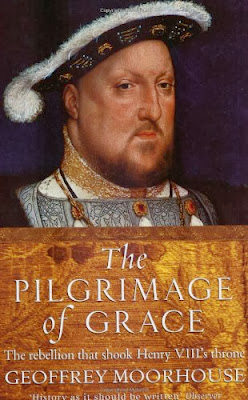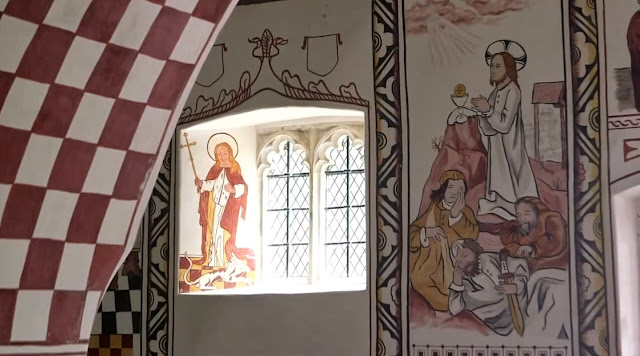Life in Catholic Lincolnshire Just Prior to the Lincolnshire Rising & Reformation.
This extract from Geoffrey Moorhouse's book entitled The Pilgrimage of Grace: The Rebellion that Shook King Henry VIII Throne (which includes the Lincolnshire Rising) gives us an insight into pre-reformation life as it would have been just before the Lincolnshire Rising.
.
Tudor Monastery Farm
.
The BBC series Tudor Monastery Farm is set just 30 years before the Lincolnshire Rising hence giving us a unique insight into the life at the time. It utilises experimental archaeology to inform historians of life in the 'Merrie Englande' of pre-reformation Tudor times. It is re-enacted in a rural setting therefore also giving us further insight into the rural life of Lincolnshire at the time just before the Rising. Needless to say there were many Monasteries at this time in Lincolnshire. The first five minutes of the video gives a brief introduction to life before the ravages and destruction of the protestant reformation took hold. It is worth noting that before this time England was at peace and the standard of living for the time was higher than it was prior to, and after, the protestant reformation. In historic terms, whilst life was still hard for the poorest, life for others was as prosperous as it had been for hundreds of years. However, as the programme demonstrates, the days of 'Merrie Englande' were soon to come to an end when Henry and Cromwell jointly put an end to the peace of the time.
Stills from this series will be used to highlight life and the Catholic Faith in Lincolnshire just prior to the Lincolnshire Rising
________________________________
The Catholic Faith Before just before the Lincolnshire Rising & Reformation
The images below give an indication of the practice of the Catholic Faith on Palm Sunday as it would have been just before the Lincolnshire Rising. As Lincolnshire is a farming county its practices were typical of other rural communities throughout England.
Latin Mass Ad orientem with the priest facing towards Jerusalem in the
East where Christ will return.
After Communion those who felt unworthy to receive the Blessed Sacrament i.e. the body of Christ, would take the Panus Benedictus - the blessed bread
Panus benedictus is still a part of the Eastern Catholic Orthodox liturgy
The blessing of branches and greenery on Palm Sunday before Mass
The Palm Sunday procession into Mass
 The Palm Sunday procession into Mass
The Palm Sunday procession into Mass After Mass the congregation would process into the village with their crosses. The greenery and crosses would be taken to homes for protection throughout the year. The leader of the procession is dressed as John the Baptist. A different prophet would be chosen every year, hence handing over aspects of the religious celebration to the lay people.
After Mass the congregation would process into the village with their crosses. The greenery and crosses would be taken to homes for protection throughout the year. The leader of the procession is dressed as John the Baptist. A different prophet would be chosen every year, hence handing over aspects of the religious celebration to the lay people.
An Example of an Early Tudor Catholic Pre-Reformation Church just prior to the
Lincolnshire Rising & Reformation.
Just by observing the small painted section of ceiling in St. James' Church, Louth it is possible to see some of the original colours that would have been present in Catholic churches before the reformation. However, Cromwell whitewashed all Catholic churches when they became protestant. It is important to note that colour was a significant part of the interior of all Catholic Churches (and still is).
All colours had meaning in that they reflected the liturgical colours of the Catholic Church. The example below is of an Early Tudor Catholic Church (i.e. just prior to the Lincolnshire Rising), which has been restored to its former glory. The small village churches surrounding Louth, as well as St. James', would have been adorned with colour similar to the example shown below.
Just by observing the small painted section of ceiling in St. James' Church, Louth it is possible to see some of the original colours that would have been present in Catholic churches before the reformation. However, Cromwell whitewashed all Catholic churches when they became protestant. It is important to note that colour was a significant part of the interior of all Catholic Churches (and still is).
All colours had meaning in that they reflected the liturgical colours of the Catholic Church. The example below is of an Early Tudor Catholic Church (i.e. just prior to the Lincolnshire Rising), which has been restored to its former glory. The small village churches surrounding Louth, as well as St. James', would have been adorned with colour similar to the example shown below.
.
Village Life
Morris Dancing was at its height before the reformation.


Mystery Plays
Mystery plays were at their height just before the Lincolnshire Rising and the dissolution of the monasteries. They were also an integral part of the Catholic Faith. Mystery (Latin for occupation) plays were presented by tradesmen from guilds such as butchers, bakers, and thatchers.They represented the story of Christs life and the salvation of man. These were the original amateur dramatics societies. These plays came to an end at the reformation and later on were replaced by professional theatre companies. Shakespeare took much of his theatrical references from the original Mystery Plays.
The Mystery Plays would have been commonplace in rural communities such as Lincolnshire and they are now returning to various parts of the country.
The following Mystery Play depicts the Harrowing of Hell and
Christ's triumph over satan.
CATHOLIC FEAST DAYS
Feast days were a major part of the Catholic Faith before the reformation (and still are particularly in the Roman Rite). Catholic feast days were celebrated without exception because the whole of the English population was Catholic. Mass would be followed by meals specific to both the season and the feast day. Although the poorest in society could not always celebrate these, this was always a time when surpluses were given to the poor. The feast day would involve a major saint or a significant moment in the life of Christ. In the example below Michaelmas (the Feast of St. Michael), Ascension day, and Whitsun (Pentecost) are celebrated.
All of these feasts are still celebrated with dignity in the Roman Rite of the Catholic Church (i.e. by those still attending the original Latin Mass).
The Twelve Days of Christmas
Work stopped for twelve days and surpluses came out in abundance to light up the the mid winter at Christmas. Every one of the twelve days had significance in the Catholic liturgical calendar.
Feasting on Christmas Day
Feasting on Christmas Day
Feasting on Christmas Day
The Feast of Saint Thomas Becket who was martyred at Christmas
Twelfth Night which was the most exuberant celebration during Christmas where there was revelry before the work started again.
Twelfth Night Feast
Twelfth Night Feast
Christmas songs were separated from dance for the first time during this period which created the first Christmas Carols.
Twelfth Night procession through the village.
The Michaelmas Feast
The Twelve Days of Christmas
Work stopped for twelve days and surpluses came out in abundance to light up the the mid winter at Christmas. Every one of the twelve days had significance in the Catholic liturgical calendar.
Feasting on Christmas Day
Feasting on Christmas Day
Feasting on Christmas Day
The Feast of Saint Thomas Becket who was martyred at Christmas
Twelfth Night which was the most exuberant celebration during Christmas where there was revelry before the work started again.
Twelfth Night Feast
Twelfth Night Feast
Christmas songs were separated from dance for the first time during this period which created the first Christmas Carols.
Twelfth Night procession through the village.
The Michaelmas Feast
The blessing before the feast
Bénedic, Dómine, nos et
haec
tua dona quae de tua largitate sumus sumpturi.
Per Christum Dóminum nostrum. Amen.
tua dona quae de tua largitate sumus sumpturi.
Per Christum Dóminum nostrum. Amen.
.
The feast with goose presented by the monastery.
New Years Day
The Feast of Solemnity of Mary, Mother of God
The procession of a blessed Holy relic through the field to ensure good crops
The Feast of Solemnity of Mary, Mother of God
The procession of a blessed Holy relic through the field to ensure good crops
Beating the Bounds on Ascension Day (which is also a Rogation day).










































+40+days+after+Easter2..jpg)
+40+days+after+Easter..jpg)
No comments:
Post a Comment